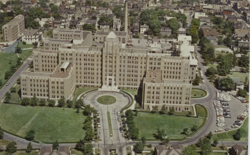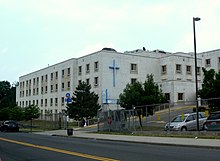
The United States Public Health Service is a collection of agencies of the Department of Health and Human Services concerned with public health, containing nine out of the department's twelve operating divisions. The Assistant Secretary for Health oversees the PHS. The Public Health Service Commissioned Corps (PHSCC) is the federal uniformed service of the PHS, and is one of the eight uniformed services of the United States.

Elizabeth Ann Bayley Seton was a Catholic religious sister in the United States and an educator, known as a founder of the country's parochial school system. After her death, she became the first person born in what would become the United States to be canonized by the Catholic Church. She also established the first Catholic girls' school in the nation in Emmitsburg, Maryland, where she likewise founded the first American congregation of religious sisters, the Sisters of Charity.

Stapleton is a neighborhood in northeastern Staten Island in New York City in the United States. It is located along the waterfront of Upper New York Bay, roughly bounded on the north by Tompkinsville at Grant Street, on the south by Clifton at Vanderbilt Avenue, and on the west by St. Paul's Avenue and Van Duzer Street, which form the border with the community of Grymes Hill.

New York Medical College is a private medical school in Valhalla, New York. Founded in 1860, it is a member of the Touro University System.
St Vincent's Hospital, St. Vincent Hospital or St. Vincent's Medical Center may refer to:
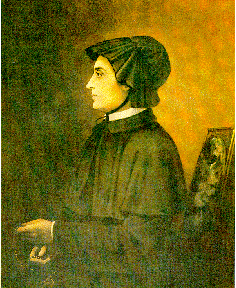
The Sisters of Charity of Saint Vincent de Paul of New York, most often known as the Sisters of Charity of New York, is a religious congregation of sisters in the Catholic Church whose primary missions are education and nursing and who are dedicated in particular to the service of the poor. The motherhouse is located at Mt. St. Vincent in the Riverdale section of the Bronx. They were founded by Elizabeth Ann Seton in 1809.
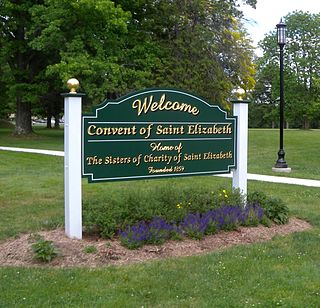
The Sisters of Charity of Saint Elizabeth are a Roman Catholic apostolic congregation of pontifical right, based in the Convent Station area of Morris Township, New Jersey, USA. The religious order was established in 1859 in Newark, New Jersey, following the example of Elizabeth Ann Seton's community that was founded in 1809 in Emmitsburg, Maryland.

In 1916, the Daughters of Charity of Saint Vincent de Paul launched a Catholic hospital called St. Vincent's Medical Center Riverside. They provide full-service tertiary care at a capacity of 528 beds.

Staten Island University Hospital (SIUH) is a member hospital of Northwell Health. It is a major tertiary referral center in Staten Island, New York City.

Richmond University Medical Center is a hospital in West New Brighton, Staten Island, New York City. The hospital occupies the buildings that were formerly St. Vincent's Medical Center, which closed in 2006. It is affiliated with the Icahn School of Medicine at Mount Sinai and the Mount Sinai Health System.

Catholic Health Initiatives (CHI) was a national Catholic healthcare system, with headquarters in Englewood, Colorado. CHI was a nonprofit, faith-based health system formed, in 1996, through the consolidation of three Catholic health systems. It was one of the United States' largest healthcare systems. In February 2019, CHI merged with Dignity Health, forming CommonSpirit Health.

Richard Bayley was a prominent New York City physician and the first chief health officer of the city. An expert in yellow fever, he helped discover its epidemiology, improved city sanitation, and authored the federal Quarantine Act of 1799. The 1788 Doctors' Riot was sparked by fears that his students were secretly removing corpses from graves in order to dissect them.

Mayo Clinic Florida is a comprehensive medical center belonging to the Mayo Clinic in Jacksonville, Florida. It is one of three Mayo campuses along with Phoenix/Scottsdale, Arizona and Rochester, Minnesota.
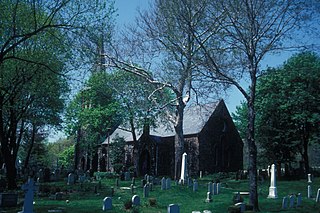
The Church of St. Andrew is a historic Episcopal church located at Arthur Kill and Old Mill Roads on the north side of Richmondtown in Staten Island, New York.

Interfaith Medical Center is a hospital located in Brooklyn, New York. With facilities in Crown Heights, Bedford-Stuyvesant, and Prospect Heights, it is a full-service non-profit community hospital that has 287 beds and serves more than 11,000 inpatients each year. It also has more than 200,000 outpatient visits and services and 50,000 emergency department visits annually. Interfaith is also a teaching hospital, with four graduate medical education residency programs, and fellowship programs in Pulmonary Medicine, Cardiology and Gastroenterology. Interfaith continues to serve as a safety-net hospital for its surrounding community since it emerged from bankruptcy in 2014.
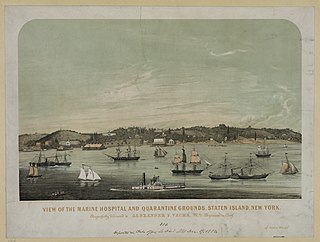
The Staten Island Quarantine War was a series of attacks on the New York Marine Hospital in Staten Island—known as "the Quarantine" and at that time the largest quarantine facility in the United States—on September 1 and 2, 1858. The attacks, perpetrated mainly by residents of Staten Island, which had not yet joined New York City, were a result of longstanding local opposition to several quarantine facilities on the island's East Shore. During the attacks, arsonists set a large fire that completely destroyed the hospital compound. At trial, the leaders of the attack successfully argued that they had destroyed the Quarantine in self-defense. Though there were no deaths as a direct result of the attacks, the conflict serves as an important historical case study of the use of quarantines as a first response.

The Bureau of Medical Services (BMS) was a unit of the United States Public Health Service (PHS) that existed in two incarnations. The first was one of three principal operating agencies of PHS from 1943 until 1966, while the second was a division of the PHS Health Services Administration from 1973 until 1982. Both incarnations of the bureau had the principal responsibility of operating the PHS hospital system that had been founded in 1789.
